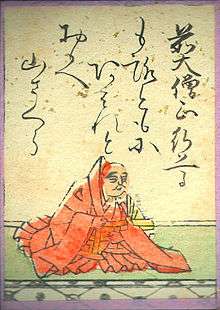Gyōson

Gyōson (行尊, 1055/1057—21 March 1135), also known as the Abbot of Byōdō-in (平等院大僧正 Byōdō-in Dai Sōjō), was a Japanese Tendai monk and waka poet of the late-Heian period. He became chief prelate of the Enryaku-ji temple in Kyoto, and one of his poems was included in the Ogura Hyakunin Isshu. Almost fifty of his poems were included in imperial anthologies, and he produced a private collection of poetry.
Biography
Gyōson was born in 1055[1][2][3] or 1057,[4][5] the son of Minamoto no Motohira (源基平).[1][2][3][4][5]
At age twelve,[2][3] he entered Mii-dera, eventually becoming its Abbot (園城寺長吏 Onjō-ji Chōri),[3][5] and practiced the Shugendō austerities of the yamabushi for many years[1] and made pilgrimages to various provinces.[4] At age 25, he received the abhisheka (阿闍梨灌頂 ajari-kanjō) from Raigō (頼豪).[3]
Later, in 1123, he rose to become Superior General of Enryaku-ji — the highest prelate of Tendai Buddhism.[1][4] He also served as Grand Almoner to emperors Shirakawa and Toba.[1][3]
He was known as the Abbot of Byōdō-in.[5]
He died on 21 March[3] 1135.[1][2][4][5]
Poetry
Forty-eight[1] of his poems were included in imperial anthologies from the Kin'yō Wakashū on.[5]
The following poem by him was included as No. 66 in Fujiwara no Teika's Ogura Hyakunin Isshu:
| Japanese text[2] | Romanized Japanese[6] | English translation[7] |
|
|
|
His poetry records his experiences on pilgrimage, and was in later ages celebrated as a spiritual precursor to the works of Saigyō.[3]
He also left a private collection, the Gyōson Daisōjō-shū (行尊大僧正集).[1][5]
Other arts
In addition to his poetry, he was also known as a skilled biwa performer and calligrapher.[3]
In later literature
As a high-ranking monk of noble birth, he appeared in many later setsuwa tales of the reigen-dan (霊験譚) genre.[3]
References
- 1 2 3 4 5 6 7 8 McMillan 2010 : 143-144 (note 66).
- 1 2 3 4 5 Suzuki et al. 2009 : 85.
- 1 2 3 4 5 6 7 8 9 10 Tokurō Yamamoto. Asahi Nihon Rekishi Jinbutsu Jiten article "Gyōson". Asahi Shinbun-sha.
- 1 2 3 4 5 Digital Daijisen entry "Gyōson". Shogakukan.
- 1 2 3 4 5 6 7 Daijirin entry "Gyōson". Sanseidō.
- ↑ McMillan 2010 : 168.
- ↑ McMillan 2010 : 68.
Bibliography
- McMillan, Peter. 2010 (1st ed. 2008). One Hundred Poets, One Poem Each. New York: Columbia University Press.
- Suzuki Hideo, Yamaguchi Shin'ichi, Yoda Yasushi. 2009 (1st ed. 1997). Genshoku: Ogura Hyakunin Isshu. Tokyo: Bun'eidō.
Further reading
- Kondō, Jun'ichi (December 1973), "Gyōson Daisōjō (Jō): Shōgai to Sakuhin" (PDF), Hokkaidō Daigaku Jinbun Kagaku Ronshū, Sapporo: Hokkaido University: 69–133, retrieved 20 August 2015
External links
- List of Gyōson's poems in the International Research Center for Japanese Studies's online waka database.
- Gyōson on Kotobank.